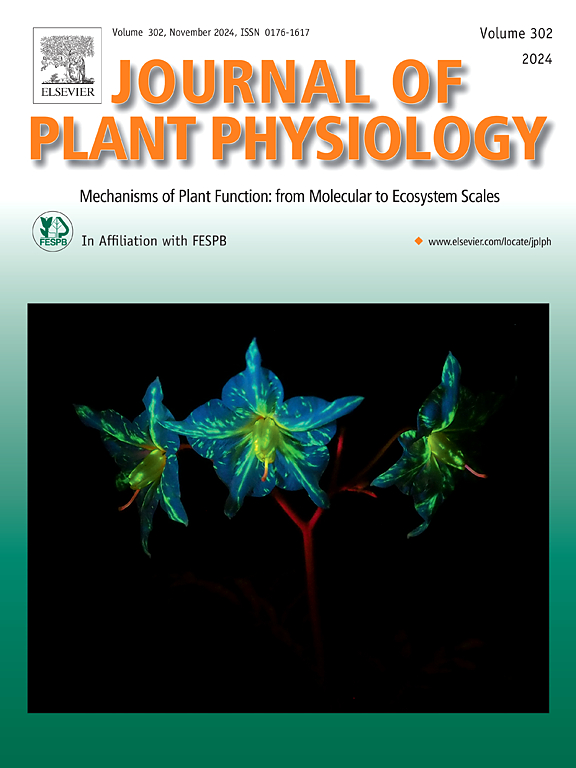MbWRKY50 confers cold and drought tolerance through upregulating antioxidant capacity associated with ROS scavenging
IF 4.1
3区 生物学
Q1 PLANT SCIENCES
引用次数: 0
Abstract
Plant growth and development can be impacted by abiotic factors, including low temperature and dryness. Numerous studies have shown that plant responses to stress are largely influenced by the WRKY transcription factors (TFs). However, there are few studies on the role of WRKY genes in the stress response of Malus plants. In this experiment, Malus baccata (L.) Borkh was selected as the material, and the WRKY family gene MbWRKY50 was cloned using a gene cloning technique. Phylogenetic tree analysis revealed that MbWRKY50 and MdWRKY50 have the highest homology. Furthermore, a green fluorescent protein (GFP) fusion protein expression assay revealed that the MbWRKY50 protein is located in the nucleus. The results of RT-qPCR showed that the expression of MbWRKY50 was increased in the roots and fully grown leaves of M. baccata, and the response to low temperature and drought environment was enhanced. The MbWRKY50 gene was transferred into tomato, which could better adapt to the cold and dry living conditions. In contrast to wild-type (WT) and untransformed (UL) tomato lines, overexpression of MbWRKY50 boosts the activities of superoxide dismutase (SOD) and peroxidase (POD). Moreover, it leads to a notable reduction in the concentrations of malondialdehyde (MDA), hydrogen peroxide (H2O2), and superoxide anion free radicals (O2−). The results showed that MbWRKY50 activated the expression levels of LeABI3, LeNCED1, LeABF4, LeDREB1, LeCBF1, and LeCBF3 by binding to cold binding factor/dehydration response element (CBF/DREB) or participating in ABA synthesis, thereby enhancing the resistance of transgenic tomatoes to low temperature and drought stress.
MbWRKY50通过上调与活性氧清除相关的抗氧化能力赋予耐旱性和耐寒性
植物的生长发育会受到非生物因素的影响,包括低温和干燥。大量研究表明,WRKY转录因子(TFs)在很大程度上影响植物对逆境的反应。然而,关于WRKY基因在苹果植物逆境响应中的作用的研究很少。在本实验中,苹果(L.)以Borkh为材料,利用基因克隆技术克隆WRKY家族基因MbWRKY50。系统进化树分析显示,MbWRKY50与MdWRKY50同源性最高。此外,绿色荧光蛋白(GFP)融合蛋白表达实验显示MbWRKY50蛋白位于细胞核中。RT-qPCR结果显示,MbWRKY50在巴卡塔根和完全生长叶片中的表达量增加,对低温和干旱环境的响应增强。将MbWRKY50基因转入番茄,使其能更好地适应寒冷干燥的生存条件。与野生型(WT)和未转化(UL)番茄系相比,MbWRKY50的过表达提高了超氧化物歧化酶(SOD)和过氧化物酶(POD)的活性。此外,它还能显著降低丙二醛(MDA)、过氧化氢(H2O2)和超氧阴离子自由基(O2−)的浓度。结果表明,MbWRKY50通过与冷结合因子/脱水反应元件(CBF/DREB)结合或参与ABA合成,激活了LeABI3、LeNCED1、LeABF4、LeDREB1、LeCBF1和LeCBF3的表达水平,从而增强了转基因番茄对低温和干旱胁迫的抗性。
本文章由计算机程序翻译,如有差异,请以英文原文为准。
求助全文
约1分钟内获得全文
求助全文
来源期刊

Journal of plant physiology
生物-植物科学
CiteScore
7.20
自引率
4.70%
发文量
196
审稿时长
32 days
期刊介绍:
The Journal of Plant Physiology is a broad-spectrum journal that welcomes high-quality submissions in all major areas of plant physiology, including plant biochemistry, functional biotechnology, computational and synthetic plant biology, growth and development, photosynthesis and respiration, transport and translocation, plant-microbe interactions, biotic and abiotic stress. Studies are welcome at all levels of integration ranging from molecules and cells to organisms and their environments and are expected to use state-of-the-art methodologies. Pure gene expression studies are not within the focus of our journal. To be considered for publication, papers must significantly contribute to the mechanistic understanding of physiological processes, and not be merely descriptive, or confirmatory of previous results. We encourage the submission of papers that explore the physiology of non-model as well as accepted model species and those that bridge basic and applied research. For instance, studies on agricultural plants that show new physiological mechanisms to improve agricultural efficiency are welcome. Studies performed under uncontrolled situations (e.g. field conditions) not providing mechanistic insight will not be considered for publication.
The Journal of Plant Physiology publishes several types of articles: Original Research Articles, Reviews, Perspectives Articles, and Short Communications. Reviews and Perspectives will be solicited by the Editors; unsolicited reviews are also welcome but only from authors with a strong track record in the field of the review. Original research papers comprise the majority of published contributions.
 求助内容:
求助内容: 应助结果提醒方式:
应助结果提醒方式:


